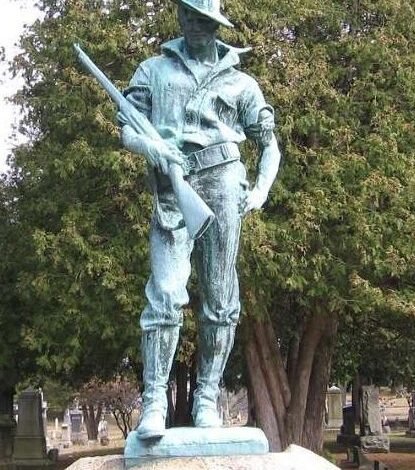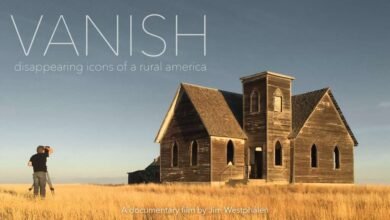“The Hiker” at Saratoga Springs Memorializes Spanish-American War Service


 The Saratoga Springs community is home to fine memorial art devoted to those who were involved in the Spanish-American War. The largest of these tributes was dedicated on May 2, 1923 in Greenridge Cemetery, and provides a tangible remembrance of those times and conditions. The sculpture, known as “The Hiker,” was created by noted artist Allen G. Newman (1875-1940) who was born in New York City and studied at the National Academy of Design.
The Saratoga Springs community is home to fine memorial art devoted to those who were involved in the Spanish-American War. The largest of these tributes was dedicated on May 2, 1923 in Greenridge Cemetery, and provides a tangible remembrance of those times and conditions. The sculpture, known as “The Hiker,” was created by noted artist Allen G. Newman (1875-1940) who was born in New York City and studied at the National Academy of Design.
The term “hiker” was used to describe the troops of the Spanish-American War (and later Philippine-American War) campaigns, similar to the term “doughboy” in World War I, and “GI Joe” in World War II.
This casting of “The Hiker” in Saratoga Springs was made by Jno. Williams, Inc. founders, and is mounted on a large 25 ton boulder of local origin, and relocated from the Woodlawn Oval on State Street.
Newman’s original casting of “The Hiker” was exhibited under the rotunda of the New York State Building at the 1907 Jamestown World Exposition where the sculpture found strong appeal to the troopers of the conflict, and was reproduced to honor veterans at many locations across the country.
US military forces fought on foreign soil for one of the first times during the Spanish-American War, in many of the warmest regions of the world. The details of “The Hiker’s” uniform; wide-brimmed hat and open collar, cartridge belt and canteen, knee-high boots and Krag Rifle, all captured in bronze, lend an sense of accuracy.

 The United States Navy battleship USS Maine had been deployed to Cuba to protect American interests from Spanish colonial masters of the island, and the explosion and sinking of the vessel in Havana Harbor on February 15, 1898 cost the lives of 266 sailors, and was the impetus for the Spanish-American War.
The United States Navy battleship USS Maine had been deployed to Cuba to protect American interests from Spanish colonial masters of the island, and the explosion and sinking of the vessel in Havana Harbor on February 15, 1898 cost the lives of 266 sailors, and was the impetus for the Spanish-American War.
The US Army hastily recruited soldiers for this conflict, who were deployed to the southern ports of New Orleans, Mobile and Tampa to prepare and stage an invasion of Cuba. More deadly to American troops than the enemy was the scourge of heat, humidity and tropical diseases they encountered.
The Saratoga dedication involved the Reverend Father John P. Chidwick, who had been aboard the Maine on her final day afloat, and one of the last sailors to escape to the lifeboats from the doomed vessel. From his unique perspective of the conflict, he delivered a stirring address about his comrades represented by “The Hiker” monument.
The honor of the ceremonial unveiling from a shroud of American flags went to Grace Fosmire, a junior at Saratoga Springs High School and daughter of the former local Spanish War Veterans commander Harry S. Fosmire, who brought the local sculpture concept to reality.
Fosmire, a resident of State Street, had enlisted as a private in Company L of the 2nd New York Volunteer Infantry in June of 1898 and, after the struggle had ended, was a long time postal carrier in Saratoga Springs. He compiled the 196 names of those who served, and would be placed on a bronze plaque on the front of the boulder.

 Displayed on the rear of the boulder supporting “The Hiker” is a USS Maine Memorial. The bas relief plaque was created by Charles Keck and also cast by Jno. Williams, Inc. founders, from metal recovered from the sunken battleship.
Displayed on the rear of the boulder supporting “The Hiker” is a USS Maine Memorial. The bas relief plaque was created by Charles Keck and also cast by Jno. Williams, Inc. founders, from metal recovered from the sunken battleship.
The United States Navy re-floated the vessel in 1912 in order to determine the cause of the explosion, recover remains, and dispose of the hulk outside of busy Havana Harbor.
Keck was a New York native who studied at the National Academy of Design and the Art Students League and then worked with Augustus Saint-Gaudens for several years. A large number of these plaques were cast, most likely from unexploded ordinance removed from USS Maine, and widely distributed around the country beginning in 1913.
It appears Keck, rather than echo the Central Park monument to the battleship created by sculptor Attilio Piccirilli which depicts “Columbia Triumphant” at the apex; instead chose a mourning allegorical female form of Liberty. She is attired in classic draping and a Phrygian helmet, or liberty cap on her lowered head.
Classic sculptors often symbolically placed the Phrygian headgear on a person who had formerly been enslaved. In her proper left hand she is carrying a shield with national emblem, surrounded by the word “PATRIOTISM” above and “DEVOTION” below. The figure of Liberty extends her proper right arm over the USS Maine’s sunken hull, toward the palm frond of eventual victory.
Saratoga Springs hosted a New York State Spanish-American War Veterans “encampment” during the monument dedication to all from Saratoga County who served, with the May 3, 1923 Saratogian reporting, “The veterans were especially pleased with the manner in which Edward C. Sweeny, proprietor of the Worden Hotel, accommodated them. He personally supervised the service and gave every attention to the entertainment of his guests.”

 The ceremony concluded with the reading of the names of the nine local residents who died during the war, which included Frederick Park McNair, son of Frances Clarke McNair and retired Navy Captain Antoine deR. McNair.
The ceremony concluded with the reading of the names of the nine local residents who died during the war, which included Frederick Park McNair, son of Frances Clarke McNair and retired Navy Captain Antoine deR. McNair.
Frederick was a member of the Saratoga Citizens Corps and graduated from the Saratoga High School, and was the fifth lineal descendant of his family to serve in the United States Army and Navy.
The Alumni Association had a memorial tablet cast by R. Geissler foundry in the Greenwich Village section of Manhattan, to honor his memory with the Latin motto, “non sibi sed patriae,” or “not for himself, but for his country.”
When the Saratoga Springs High School was lost to fire in 1923, the McNair Memorial survived and was re-dedicated in the replacement building, which is the present Lake Avenue Elementary School.
Another name read aloud was Reubena Hyde Walworth, Army Nurse, who bravely and courageously eased the suffering of soldiers and sailors removed from tropical battlefields to the detention hospital at hastily constructed Camp Wikoff, at Long Island’s Montauk Point.

 She had charge of the contagious ward, where those anguished with measles, typhoid fever, yellow fever, and diphtheria, all complicated with malarial exposure, found her comfort.
She had charge of the contagious ward, where those anguished with measles, typhoid fever, yellow fever, and diphtheria, all complicated with malarial exposure, found her comfort.
Her earthly remains repose in Greenridge Cemetery, with the inscription on her impressive obelisk monument reading: “She served her flag – not as a man, but better still: as only woman can.”
Illustrations, from above: “The Hiker” at Saratoga Springs; Spanish-American War veteran Harry S. Fosmire advertisement seeking names of those to be included on “The Hiker” monument; bas relief USS Maine Memorial tablet on the rear of the boulder supporting “The Hiker” in Saratoga Springs; Saratoga High School Alumni Association memorial tablet cast by R. Geissler foundry, from an advertisement published in The Monumental News, January, 1900; and Camp Wikoff at Montauk Point (Library of Congress).
Source link




